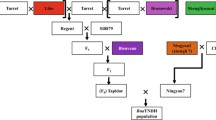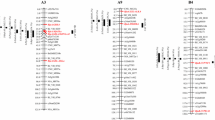Abstract
Seed size and seed metabolites have been the targets of direct or indirect selection during domestication and subsequent crop breeding. Understanding these traits and associated genetics can prove very useful for plant translational research. Large germplasm assemblage (235) of Brassica juncea and its progenitor species (B. rapa and B. nigra) was evaluated to establish seed trait variations for seed size and seed metabolites. Seeds were smallest in B. nigra and largest in B. juncea. Australian B. juncea and Indian B. rapa var brown sarson types averaged more seed oil content. Seed size and oil content were generally higher in modern cultivars in comparison to the land races. Allelic diversity for known associated genes for seed-size and oil-content (AP2, ARF2, TTG2, GRF2, GL2, CYP78A5, CYP78A6, MINI3, IKU2, IKU1, BRI1, DGAT, GPDH, LPAAT, GPAT and DA1) was studied so as to infer the effect of domestication on seed traits. Three genes (IKU1, IKU2, AP2) in B. rapa, two (TTG2 and GL2) in B. nigra and two (IKU1 and GRF2) in natural B. juncea were identified as targets of selection on the basis of Fst outlier and/or sequence diversity tests. We report parallel divergence for seed traits between B. juncea and B. rapa. Directional selection appeared stronger for seed-size as compared to correlated seed metabolites. Positive selection on seed-size is likely to have played a significant role in structuring regional variation in the germplasm.



Similar content being viewed by others
References
Doebley JF, Gaut BS, Smith BD (2006) The molecular genetics of crop domestication. Cell 127:1309–1321. https://doi.org/10.1016/j.cell.2006.12.006
Dong Y, Wang YZ (2015) Seed shattering: from models to crops. Front Plant Sci 6:476. https://doi.org/10.3389/fpls.2015.00476
Doughty J, Aljabri M, Scott RJ (2014) Flavonoids and the regulation of seed size in Arabidopsis. Biochem Soc Trans 42(2):364–369. https://doi.org/10.1042/BST20140040
Orsi CH, Tanksley SD (2009) Natural variation in an ABC transporter gene associated with seed size evolution in tomato species. PLoS Genet 5:e1000347. https://doi.org/10.1371/journal.pgen.1000347
Li N, Li Y (2015) Maternal control of seed size in plants. J Exp Bot 66(4):1087–1097. https://doi.org/10.1093/jxb/eru549
Nadolska-Orczyk A, Rajchel IK, Orczyk W, Gasparis S (2017) Major genes determining yield-related traits in wheat and barley. Theor Appl Genet 130(6):1081–1098. https://doi.org/10.1007/s00122-017-2880-x
Jofuku KD, Omidyar PK, Gee Z, Okamuro JK (2005) Control of seed mass and seed yield by the floral homeotic gene APETALA2. Proc Natl Acad Sci USA 102:3117–3122. https://doi.org/10.1073/pnas.0409893102
Li N, Peng W, Shi J, Wang X, Liu G, Wang H (2015) The Natural Variation of Seed Weight Is Mainly Controlled by Maternal Genotype in Rapeseed (Brassica napus L.). PLoS ONE 10:e0125360. https://doi.org/10.1371/journal.pone.0125360
Cai G, Yang Q, Yang Q, Zhao Z, Chen H, Wu J, Fan C, Zhou Y (2012) Identification of candidate genes of QTLs for seed weight in Brassica napus through comparative mapping among Arabidopsis and Brassica species. BMC Genet 13:105. https://doi.org/10.1186/1471-2156-13-105
Zong Y, Yao S, Crawford GW et al (2017) Selection for oil content during soybean domestication revealed by X-ray tomography of ancient beans. Sci Rep 7:43595. https://doi.org/10.1038/srep43595
Zhang D, Sun L, Li S et al (2018) Elevation of soybean seed oil content through selection for seed coat shininess. Nat Plants 4(1):30–35. https://doi.org/10.1038/s41477-017-0084-7
Chai G, Bai Z, Wei F, King GJ, Wang C, Shi L, Dong C, Chen H, Liu S (2010) Brassica GLABRA2 genes: analysis of function related to seed oil content and development of functional markers. Theor Appl Genet 120:1597–1610. https://doi.org/10.1007/s00122-010-1279-8
Liu J, Hua W, Yang H-L, Zhan G-M, Li R-J, Deng L-B, Wang X-F, Liu G-H, Wang H-Z (2012) The BnGRF2 gene (GRF2-like gene from Brassica napus) enhances seed oil production through regulating cell number and plant photosynthesis. J Exp Bot 63:3727–3740. https://doi.org/10.1093/jxb/ers066
Liu F, Xia Y, Wu L, Fu D, Hayward A, Luo J, Yan X, Xiong X, Fu P, Wu G, Lu C (2015) Enhanced seed oil content by overexpressing genes related to triacylglyceride synthesis. Gene 557(2):163–171. https://doi.org/10.1016/j.gene.2014.12.029
Lock YY, Snyder CL, Zhu W, Siloto RM, Weselake RJ, Shah S (2009) Antisense suppression of type 1 diacylglycerol acyltransferase adversely affects plant development in Brassica napus. Physiol Plant 137(1):61–71. https://doi.org/10.1111/j.1399-3054.2009.01258.x
Gacek K, Bayer PE, Bartkowiak-Broda I et al (2016) Genome-wide association study of genetic control of seed fatty acid biosynthesis in Brassica napus. Front Plant Sci 7:2062. https://doi.org/10.3389/fpls.2016.02062
Qu C, Jia L, Fu F et al (2017) Genome-wide association mapping and Identification of candidate genes for fatty acid composition in Brassica napus L. using SNP markers. BMC Genom 18:232. https://doi.org/10.1186/s12864-017-3607-8
Chao H, Wang H, Wang X et al (2017) Genetic dissection of seed oil and protein content and identification of networks associated with oil content in Brassica napus. Sci Rep 7:46295. https://doi.org/10.1038/srep46295
Mitra R, Bhatia CR (1979) Bioenergetic considerations in the improvement of oil content and quality in oil-seed crops. Theor Appl Genet 54:41–47. https://doi.org/10.1007/BF00265707
Appelqvist L (1968) Rapid methods of lipid extractions and fatty acid methyl ester preparation for seed and leaf tissue with special remarks on preventing the accumulation of lipids contaminants. Ark Kemi 28:551–570
Kaur P, Banga S, Kumar N, Gupta S, Akhatar J, Banga SS (2014) Polyphyletic origin of Brassica juncea with B. rapa and B. nigra (Brassicaceae) participating as cytoplasm donor parents in independent hybridization events. Am J Bot 101:1157–1166. https://doi.org/10.3732/ajb.1400232
Doyle JJ, Doyle JL (1990) Isolation of plant DNA from fresh tissue. Focus 12:13–15
Evanno G, Regnaut S, Goudet J (2005) Detecting the number of clusters of individuals using the software STRUCTURE: a simulation study. Mol Ecol 14:2611–2620. https://doi.org/10.1111/j.1365-294X.2005.02553.x
Peakall R, Smouse PE (2006) Genalex 6: genetic analysis in Excel. Population genetic software for teaching and research. Mol Ecol Notes 6:288–295. https://doi.org/10.1111/j.1471-8286.2005.01155.x
Bradbury PJ, Zhang Z, Kroon DE, Casstevens TM, Ramdoss Y, Buckler ES (2007) TASSEL: software for association mapping of complex traits in diverse samples. Bioinformatics 23:2633–2635. https://doi.org/10.1093/bioinformatics/btm308
Excoffier L, Lischer HEL (2010) Arlequin suite ver 3.5: a new series of programs to perform population genetics analyses under Linux and Windows. Mol Ecol Resour 10:564–567. https://doi.org/10.1111/j.1755-0998.2010.02847.x
Antao T, Lopes A, Lopes RJ, Beja-Pereira A, Luikart G (2008) LOSITAN: a workbench to detect molecular adaptation based on a Fst-outlier method. BMC Bioinform 9:323. https://doi.org/10.1186/1471-2105-9-323
Foll M, Gaggiotti O (2008) A genome-scan method to identify selected loci appropriate for both dominant and codominant markers: a bayesian perspective. Genetics 180:977–993. https://doi.org/10.1534/genetics.108.092221
Grabherr MG, Haas BJ, Yassour M et al (2011) Full-length transcriptome assembly from RNA-Seq data without a reference genome. Nature Biotechnol 9:644–652. https://doi.org/10.1038/nbt.1883
Thompson JD, Higgins DG, Gibson TJ (1994) CLUSTALW: Improving the sensitivity of progressive multiple sequence alignment through sequence weighting, position-specific gap penalties and weight matrix choice. Nucleic Acids Res 22:4673–4680. https://doi.org/10.1093/nar/22.22.4673
Rozas J, Sanchez-Delbarrio JC, Messeguer X, Rozas R (2003) DnaSP, DNA polymorphism analyses by the coalescent and other methods. Bioinformatics 19:2496–2497. https://doi.org/10.1093/bioinformatics/btg359
Garcia D, Saingery V, Chambrier P, Mayer U, Jurgens G, Berger F (2003) Arabidopsis haiku mutants reveal new controls of seed size by endosperm. Plant Physiol 131:1661–1670. https://doi.org/10.1104/pp.102.018762
Mortazavi A, Williams BA, McCue K, Schaeffer L, Wold B (2008) Mapping and quantifying mammalian transcriptomes by RNA-SEq. Nat Methods 5:621–628. https://doi.org/10.1038/nmeth.1226
Bots M, Laga B. Mouchel C (2014) Brassica plants comprising mutant DA1 alleles. Patent WO2014161908A1. http://www.patentsencyclopedia.com/app/20160040180
Wang JL, Tang MQ, Chen S, Zheng XF, Mo HX, Li SJ, Wang Z, Zhu KM, Ding LN, Liu SY, Li YH, Tan XL (2017) Down-regulation of BnDA1, whose gene locus is associated with the seeds weight, improves the seeds weight and organ size in Brassica napus. Plant Biotechnol J 15(8):1024–1033. https://doi.org/10.1111/pbi.12696
Machado HE, Lawrie DS, Petrov DA (2017) Strong purifying selection on codon usage bias. bioRxiv 106476. https://doi.org/10.1101/106476
Savadi S, Naresh V, Kumar V, Dargan S, Gupta NC, Chamola R, Bhat SR (2015) Effect of overexpression of Arabidopsis thaliana SHB1 and KLUH genes on seed weight and yield contributing traits in Indian mustard (Brassica juncea L. (Czern.)). Indian J Genet Pl Br 75:349–356. https://doi.org/10.5958/0975-6906.2015.00055.3
Acknowledgements
The studies were financially supported by the Indian Council of Agricultural Research under ICAR National Professor Project “Broadening the genetic base of Indian mustard (Brassica juncea) through alien introgressions and germplasm enhancement” awarded to S.S.B. The authors thank “Plant Gene Resources of Canada, Agriculture and Agri-Food Canada” for providing many of the germplasm lines used in our studies.
Author information
Authors and Affiliations
Corresponding author
Ethics declarations
Conflict of interest
The authors declare that they have no conflict of interest.
Research involving human participants and/or animals
This article does not contain any studies with human participants or animals performed by any of the authors.
Additional information
Publisher’s Note
Springer Nature remains neutral with regard to jurisdictional claims in published maps and institutional affiliations.
Electronic supplementary material
Below is the link to the electronic supplementary material.
11033_2019_4591_MOESM2_ESM.tiff
Decay of linkage disequilibrium (LD) in different subpopulations of B. rapa; A) rapCA for DA1, CYP78A6, CYP78A5, AP2, GRF2, MINI3, IKU2, IKU1, BRI1, DGAT, GPDH, LPAAT, GPAT and GL2 genes, B) rapCAN for DA1, TTG2, CYP78A6, CYP78A5, AP2, GRF2, MINI3, IKU2, IKU1, BRI1, DGAT, GPDH, LPAAT, GPAT and GL2 genes, C) rapIT for DA1, TTG2, CYP78A6, CYP78A5, AP2, GRF2, MINI3, IKU2, IKU1, BRI1, DGAT, GPDH, LPAAT, GPAT and GL2 genes, D) rapPB for DA1, CYP78A6, CYP78A5, AP2, GRF2, MINI3, IKU2, IKU1, BRI1, DGAT, GPDH, LPAAT, GPAT and GL2 genes and E) rapIB for DA1, TTG2, CYP78A6, AP2, GRF2, MINI3, IKU2, IKU1, BRI1, DGAT, GPDH, LPAAT, GPAT and GL2 genes—Supplementary Fig. 1 (TIFF 1520 KB)
11033_2019_4591_MOESM3_ESM.tiff
Decay of linkage disequilibrium (LD) in different subpopulations of B. nigra; A) nigCAN for DA1, ARF2, CYP78A6, CYP78A5, AP2, GRF2, MINI3, IKU2, IKU1, BRI1, DGAT, LPAAT, GPAT and GL2 genes and B) nigI for DA1, TTG2, CYP78A5, AP2, GRF2,MINI3, IKU2, IKU1, BRI1, DGAT, LPAAT, GPAT and GL2 genes—Supplementary Fig. 2 (TIFF 675 KB)
11033_2019_4591_MOESM4_ESM.tiff
Decay of linkage disequilibrium (LD) in different subpopulations of B. juncea; A) junA for DA1, TTG2, CYP78A6, CYP78A5, AP2, ARF2, GRF2, MINI3, IKU2, IKU1, BRI1, DGAT, GPDH, LPAAT, GPAT and GL2 genes, B) junC for DA1, TTG2, CYP78A5, AP2, GRF2, MINI3, IKU2, IKU1, BRI1, DGAT, GPDH, LPAAT, GPAT and GL2 genes, C) junEE for DA1, TTG2, CYP78A6, CYP78A5, AP2, GRF2, MINI3, IKU2, IKU1, BRI1, DGAT, GPDH, LPAAT, GPAT and GL2 genes and D) junI for DA1, TTG2, CYP78A6, CYP78A5, AP2, GRF2, MINI3, IKU2, IKU1, BRI1, DGAT, GPDH, LPAAT, GPAT and GL2 genes—Supplementary Fig. 3 (TIFF 1334 KB)
11033_2019_4591_MOESM5_ESM.tiff
Candidate loci under directional and balancing selection identified using Bayescan, Arlequin and LOSITAN softwares in B. rapa (A–C), B. nigra (D–F) and B. juncea (G–I)—Supplementary Fig. 4 (TIFF 327 KB)
Rights and permissions
About this article
Cite this article
Sra, S.K., Sharma, M., Kaur, G. et al. Evolutionary aspects of direct or indirect selection for seed size and seed metabolites in Brassica juncea and diploid progenitor species. Mol Biol Rep 46, 1227–1238 (2019). https://doi.org/10.1007/s11033-019-04591-3
Received:
Accepted:
Published:
Issue Date:
DOI: https://doi.org/10.1007/s11033-019-04591-3




